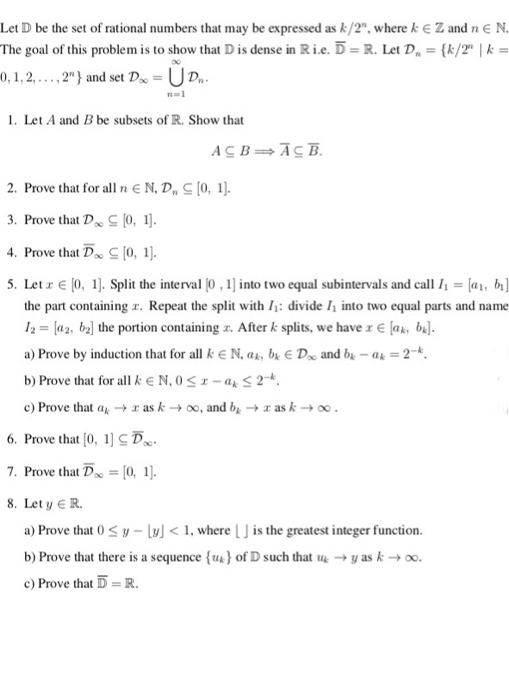Question
Let D be the set of rational numbers that may be expressed as k/2, where k Z and n N. The goal of this

Let D be the set of rational numbers that may be expressed as k/2", where k Z and n N. The goal of this problem is to show that D is dense in Ri.e. D= R. Let D = {k/2" | k= 0,1,2,...,2") and set D = =DR. 1. Let A and B be subsets of R. Show that A C B = A SB. 2. Prove that for all n N, D, C [0, 1]. 3. Prove that D[0, 1]. 4. Prove that D[0, 1]. 5. Let x [0, 1]. Split the interval [0, 1] into two equal subintervals and call I = [a, b] the part containing z. Repeat the split with I: divide I; into two equal parts and name 12 = [02, 6] the portion containing z. After k splits, we have r [a, b]. a) Prove by induction that for all k N. a, b D and bak = 2-k b) Prove that for all k N, 0z-a 2-*. c) Prove that a ras k oo, and b I ask o. 6. Prove that [0, 1] D... 7. Prove that D = [0, 1]. 8. Let y R. a) Prove that 0 y - [y]
Step by Step Solution
3.39 Rating (171 Votes )
There are 3 Steps involved in it
Step: 1

Get Instant Access to Expert-Tailored Solutions
See step-by-step solutions with expert insights and AI powered tools for academic success
Step: 2

Step: 3

Ace Your Homework with AI
Get the answers you need in no time with our AI-driven, step-by-step assistance
Get StartedRecommended Textbook for
An Introduction to Measure Theoretic Probability
Authors: George G. Roussas
2nd edition
128000422, 978-0128000427
Students also viewed these Accounting questions
Question
Answered: 1 week ago
Question
Answered: 1 week ago
Question
Answered: 1 week ago
Question
Answered: 1 week ago
Question
Answered: 1 week ago
Question
Answered: 1 week ago
Question
Answered: 1 week ago
Question
Answered: 1 week ago
Question
Answered: 1 week ago
Question
Answered: 1 week ago
Question
Answered: 1 week ago
Question
Answered: 1 week ago
Question
Answered: 1 week ago
Question
Answered: 1 week ago
Question
Answered: 1 week ago
Question
Answered: 1 week ago
Question
Answered: 1 week ago
Question
Answered: 1 week ago
Question
Answered: 1 week ago
Question
Answered: 1 week ago
Question
Answered: 1 week ago
View Answer in SolutionInn App



